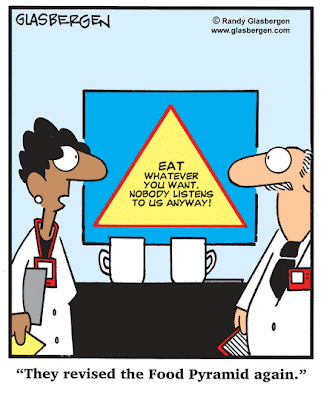Friday was my first appointment for my Sandostatin shot
after my post-op visit last month. It
has been 5+ weeks post-surgery and I am still quite fatigued with not much of
an appetite. I don’t have much pain and
have lost 15 pounds. I’ve been pretty
conservative with eating, sticking to a low fiber diet. I’m not that hungry and not craving anything
in particular so it has not been too hard to be on this boring diet. I probably do not need to lose too much more
weight but another 5 pounds would give me some good leeway when I do get my
appetite back! This is the first time
I’ve been below the top of my body mass index (BMI) range for several
years! Dr. Chan suggested I meet with a
nutritionist when I was in Boston for this appointment. I did and the session
was very helpful.
I don’t consider myself a nutritional expert at all. I
don’t know all the technical terms or even the difference between vitamins and
minerals. I understand the food pyramid
and used to eat a diet that I thought was pretty nutritious.
My basic issues from a nutritional standpoint are that I
am losing weight at about a pound a week and have little appetite. I have had gas “issues” for about a
week during the past month. I had this
gas problem prior to surgery, but it was minor, not occurring every month and
only for about a day or two when it happened.
I think of this gas as “Sandostatin gas” because:
1) I never had it prior to taking Sandostatin LAR
2) It
does not seem to have any relation to anything I’ve eaten and does not respond
to over the counter medications like Gas-X
The Sandostatin gas seems worse since my surgery. It’s only been 5 weeks and I’m hoping it gets
better over time.
The nutritionist I met with was very nice and
competent. She gave me a list of foods
that may cause gas that consisted of the following items:
·
Beverages: beer, carbonated drinks, red wine
·
Dairy: milk, cheese, cottage cheese, yogurt, ice
cream
·
Dried
legumes: baked beans,
beans like kidney, pinto, garbanzos, lima and navy, split peas, lentils and
soybeans
·
Fruits: apples (raw), prunes
·
Vegetables: asparagus, broccoli, brussel sprouts,
cabbage, cauliflower, corn, cucumber, kohrabi, leeks, onions, peppers,
radishes, sauerkraut and turnips
·
High
fat foods: fried foods,
fatty meats, gravies, cream sauces and pastries
·
Other: garlic, chewing gum, artificial sweeteners
such as mannitol, maltitol, sorbitol or any other sugar alcohol.
Her suggestions were to do the following 3 things, but only
one at a time. She wanted to make sure
that if something works, we would know which approach helped. She said to try
each suggestion for 5-7 days and see what happens. The suggestions were:
1. Reduce
the gassy foods and lactose (dairy foods)
2. Try
a probiotic supplement
3. Try
a digestive enzyme
She said that a lot of carcinoid patients have gas issues
but did not go so far as to say it was from the Sandostatin, although she did
not rule it out.
I know next to nothing about probiotics or digestive
enzymes so I asked for advice on choices.
She said to try a probiotic product called Ultimate Flora in a dose of 30
billion. She said it was available at
the Vitamin Shoppe. Good thing I asked
because when I went in to the Vitamin Shoppe, there was a whole wall of
probiotics – I would never have known which one to select. I figured I’d start with the probiotic pill
and see what transpires.
The nutritionist did not give me a recommendation on a
digestive enzyme but other carcinoid patients have suggested papaya extract or
a product called Digest Gold. The
Vitamin Shoppe stocks these products as well.
I think I’ll save the low lactose diet for my last option
because I like my yogurt and dairy so this will be bit harder for me. Hopefully either the probiotic or digestive
enzyme will work.
In addition to the above suggestions, she said I could
branch out from peeled apples and pears to not peeling them and adding grapes
or strawberries. I can even eat the
whole baked potato including the skin! I
should switch from Orgain as my protein shake to a no lactose product like
Ensure or Boost when I do the low lactose week.
The nutritionist also recommended that I take an extra forkful of food,
even if I feel full because my stomach has most likely shrunk since I have not
been eating that much. She also said I
could drink white wine! I’ll drink to
that once I feel a bit better!







